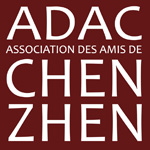
 |
||||||||
|
|
|
|
|
|
|
|
|
|
|
|
Oeuvres - Permanentes
L'œuvre se compose de deux grandes « assiettes » métalliques sphériques de 9m de diamètre, assemblées dos à dos et tenues verticalement au-dessus du sol par un piétement, autour desquelles sont fixées 70 chaises. Métaphore à la fois du globe terrestre et du banquet universel, Constellation Humaine symbolise les champs modernes du dialogue et de l'échange fraternel entre les peuples.
Unveiled on 12th February 2008, in the presence of Christophe Girard, Deputy Mayor responsible for Culture, and Jérôme Coumet, the Mayor of the 13th district, Chen Zhen’s work of art marks the strong link uniting Paris to the Asian community which has historically settled in the district. The ‘Gushing Fountain’ by Chen Zhen takes the shape of a dragon, of which the twists and turns of the tail develop in the heart of the new architecture which rises on the balcony of the Quai d’Austerlitz. Taking place above the underground Eaux de Paris factory, the dragon’s body, ‘rising and disappearing, sinking in the earth and shooting up in the air’, symbolises the continual and energetic flow of the hydraulic network which runs over the site, and with its lights illuminates the glints of the megalopolis. It is ‘the life and soul of the place…’. "I highlight this convergence of the dynamism of the water in this precise context and the energetic emergence of the relationship between water and the town, man and his universe." (Chen Zhen)
"L'Autel du Ciel" (1993)
Location:
Taejon Expo 93, Taedok Science Town, Corée du Sud
"Lesson of Ethnology" (1999) Located in the northern part of Haidian District in Beijing, Yuanmingyuan is composed of three comparatively independent but interconnected gardens : Yuanmingyuan, Changchunyuan (Garden of Eternal Spring), and (Garden of Blossoming Spring). Covering an area of about 350 hectares, Yuanmingyuan was a vast landscaped garden at once grand in scale and enchanting in scenery. Its green hills and exquisite architecture were laid out with picturesque flowers. As to close sight, the rolling hills and maze of streams and lakes divided the whole garden into more than 100 scenes and composed more than 50 autonomous landscapes , their captivating beauty enhanced by a host of about 600 units of pavilions, corridors, islands, and bridges. About 40 percent of the garden was covered by rivers and lakes, connected into an integral system by winding streams and dotted with more 250 hills and rock formations. It had a more extraordinary history concerning an incredible collaboration between Chinese architects, artisans and Europeans, on the construction of European palaces in Yuanmingyuan which showed a model of "what the outside world could produce the most beautiful and the most rare". Yuanmingyuan was not only famed for its beauty. It was also an imperial museum with a vast collection of cultural treasures. The French writer Victor Hugo once remarked, "With all its treasures, Notre Dame in Paris is no match for Yuanmingyuan, that enormous and magnificent museum in the East." But, the intrusion of occidentals will be fatal. On October 1860, the Anglo-French forces sacked and looted Yuanmingyuan and burned it to the ground. From then on, the garden suffered continual damage at the hands of the warlords, bandits, and the Eight-Power Allied Forces. Its former beauty and glory no more, the entire garden lay in clusters of ruins and debris.
Make a research at La Bibliothèque Nationale de Paris to find out these 40 landscape paintings and to make a photographic copy of them in respecting the original dimension (about 80 x 80 cm) of each painting. Put two screens, the first one represents the actual situation of this garden, second one represents a historical picture which showed the whole landscape of Yuanmingyuan To make "reappear" this formal tragedy which was occurred for the most of Europeans is to "offer a gift" to the Museum of Ethnology. It's also a "crucial ethnologic object": a trace of construction and destruction of culture, for enlarging and enriching the idea and the vision of such a kind of museum: it concerns not only the "objects", but also the "acts" behind the materials. In other words, "Lesson of Ethnology" tries to question if Museum of Ethnology is only a tool to distribute cultures and histories of "others", or it's also a catalyse for releasing cultural and historical consciousness in terms of "our" behaviours as dominant power ? Yuanmingyuan was one of rare examples of "the meeting between different cultures" at that time. A realised dream became a nightmare which entered in the legend. So this "Lesson of Ethnology" intends to borrow this old story to interrogate our actual way of doing "multiculturalism": from what point of view to look at the others, to be looked by others and to look at ourselves ? CHEN Zhen
"Résonance" (1994) La pièce résonance devrait être sonore, ce que suggèrent son titre et sa forme: une gigantesque cloche (symbole du pouvoir traditionnel en chine) et des haut-parleurs (symboles du communisme et de la propagande). En réalité, elle est totalement silencieuse, comme les gens qui vivent sous la dictature. Le silence est l'aspect le plus cruel de la violence du pouvoir... Lorsque la pièce a été définitivement installée dans le parc du musée, j'y ajouté un système d'enregistrement et d'amplification des sons naturels: résonance avec le contexte... CHEN Zhen |